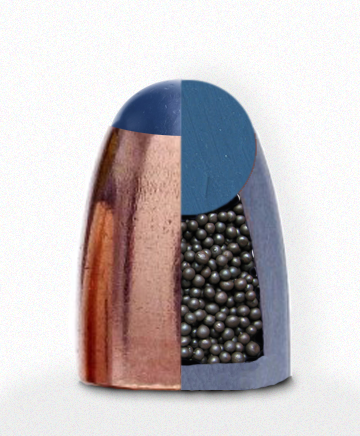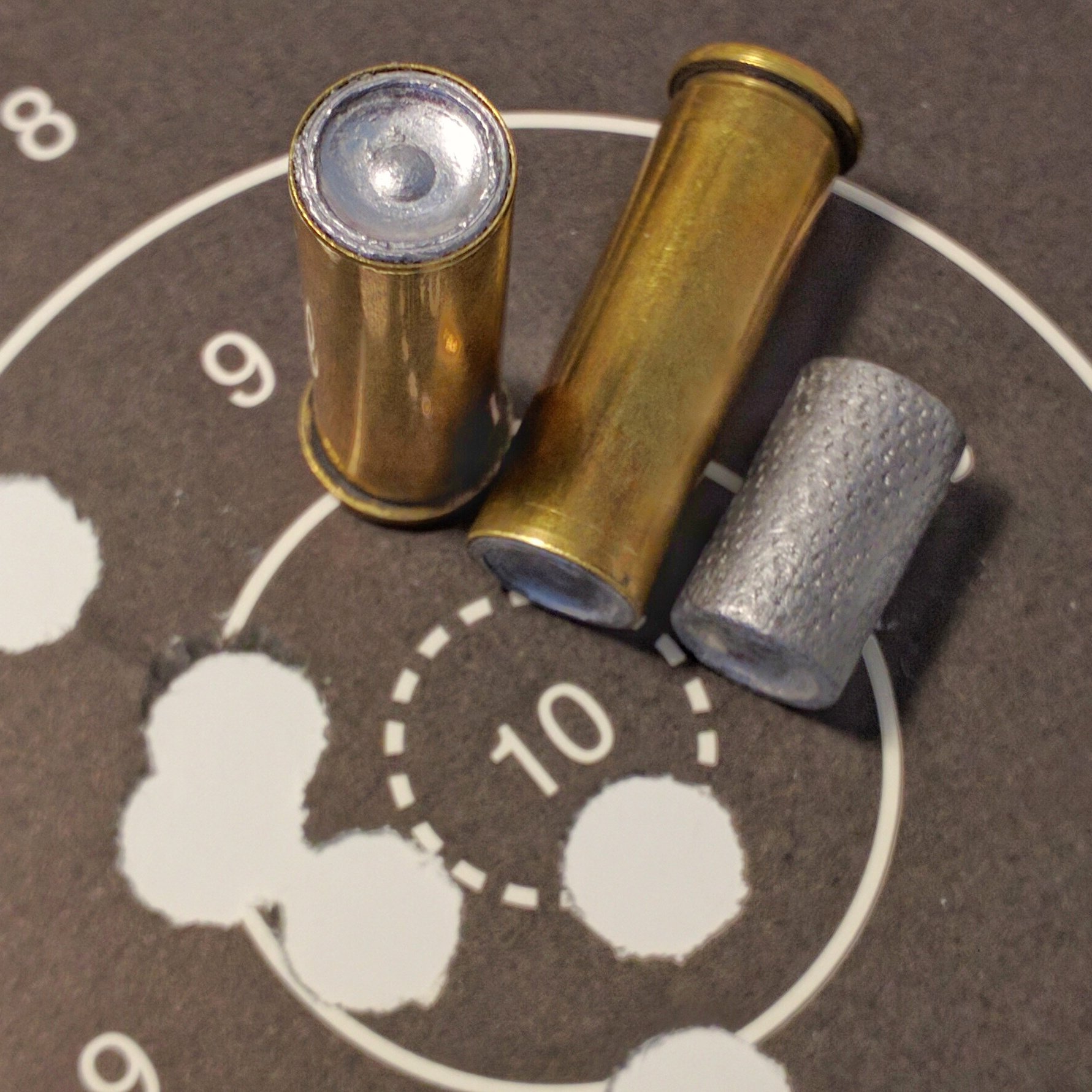|
Glaser Safety Slug
Glaser Safety Slug is a frangible bullet made by Cor-Bon/Glaser, a subsidiary of Dakota Ammo, an American ammunition company formerly based in Sturgis, South Dakota. The Glaser Safety Slug was developed by Jack Canon in 1975, the same year the company was founded by Armin Glaser. History The original round was a hand-made hollow-point bullet filled with No. 12 birdshot () with a flat polymer cap. To improve ballistic performance, a polymer-tipped round ball was introduced in 1987, and the current compressed core form was first sold in 1988. The formulation of the polymer was also changed in 1994 to improve fragmentation reliability. Performance The company produces bullets in calibers from .25 to .45 for pistols and from .223 to .30-06 for rifles. Each caliber comes in two forms, "blue" and "silver", the latter having greater penetrating power due to the use of no. 6 birdshot rather than no. 12. The projectile in the cartridge is of a lighter weight than more conventiona ... [...More Info...] [...Related Items...] OR: [Wikipedia] [Google] [Baidu] |
Bullet
A bullet is a kinetic projectile, a component of firearm ammunition that is shot from a gun barrel. They are made of a variety of materials, such as copper, lead, steel, polymer, rubber and even wax; and are made in various shapes and constructions (depending on the intended applications), including specialized functions such as hunting, target shooting, training, and combat. Bullets are often tapered, making them more aerodynamic. Bullet size is expressed by weight and diameter (referred to as "caliber") in both imperial and metric measurement systems. Bullets do not normally contain explosives but strike or damage the intended target by transferring kinetic energy upon impact and penetration. Description The term ''bullet'' is from Early French, originating as the diminutive of the word ''boulle'' (''boullet''), which means "small ball". Bullets are available singly (as in muzzle-loading and cap and ball firearms) but are more often packaged with propellant as a cartri ... [...More Info...] [...Related Items...] OR: [Wikipedia] [Google] [Baidu] |
Urban Warfare
Urban warfare is warfare in urban areas such as towns and cities. Urban combat differs from combat in the open at both Military operation, operational and the Military tactics, tactical levels. Complicating factors in urban warfare include the presence of civilians and the complexity of the urban terrain. Urban combat operations may be conducted to capitalize on strategic or tactical advantages associated with the possession or the control of a particular urban area or to deny these advantages to the enemy. It is considered to be arguably the most difficult form of warfare. Fighting in urban areas negates the advantages that one side may have over the other in armor, heavy artillery, or air support. Ambushes laid down by small groups of soldiers with handheld anti-tank weapons can destroy entire columns of modern armor (as in the Battle of Grozny (1994–95), First Battle of Grozny), while artillery and air support can be severely reduced if the "superior" party wants to limit ci ... [...More Info...] [...Related Items...] OR: [Wikipedia] [Google] [Baidu] |
Hollow-base Bullet
A hollow-base bullet is a firearm bullet with a pit or hollow in its base which expands upon being fired, forcing the base to engage with the barrel grooves and obturating the bore more as the bullet travels through the barrel. Hollowing the base makes the bullet more front-heavy, which improves aerodynamic stability and accuracy. History Two men have been credited with the invention of the hollow-base bullet: Captain Claude-Étienne Minié of the French Army and William Greener. The initial reason for developing a hollow-base bullet was to improve usability and performance of muzzle-loading rifles using black powder propellant. See also * Hollow-point bullet * Minié ball * Tamisier * Nessler ball The Nessler ball, or ''balle Nessler'', is a type of muzzle-loading musket bullet. It was developed to increase the accuracy and range of smoothbore muskets and was used in the Crimean War. It featured a short conical-cylindrical soft lead bullet ... References * Notes {{ ... [...More Info...] [...Related Items...] OR: [Wikipedia] [Google] [Baidu] |
Hydra-Shok
Hydra-Shok is a type of hollow-point projectile made by Federal Premium Ammunition. It was originally patented by ammunition designer Tom Burczynski. Hydra-Shok was released in 1988 after the FBI requested a bullet with better terminal ballistics than traditional cup and core projectiles. Design The Hydra-Shok bullet features a hollow-point construction which contains a distinctive central post in the base of the hollow. This design makes such bullets easily identifiable in autopsy examinations of gunshot victims. The manufacturer stated that the scored jacket and center post design provide a "programmed" expansion. There has been much debate regarding the bullet's unreliable expansion when fired through clothing or media other than ballistic gelatin. The bullet typically displays very rapid expansion, resulting in a larger but more shallow wound channel than would be typical from most other bullet configurations in the same caliber and of similar weight. [...More Info...] [...Related Items...] OR: [Wikipedia] [Google] [Baidu] |
Gold Dot
Gold is a chemical element; it has chemical symbol Au (from Latin ) and atomic number 79. In its pure form, it is a bright, slightly orange-yellow, dense, soft, malleable, and ductile metal. Chemically, gold is a transition metal, a group 11 element, and one of the noble metals. It is one of the least reactive chemical elements, being the second-lowest in the reactivity series. It is solid under standard conditions. Gold often occurs in free elemental (native state), as nuggets or grains, in rocks, veins, and alluvial deposits. It occurs in a solid solution series with the native element silver (as in electrum), naturally alloyed with other metals like copper and palladium, and mineral inclusions such as within pyrite. Less commonly, it occurs in minerals as gold compounds, often with tellurium (gold tellurides). Gold is resistant to most acids, though it does dissolve in aqua regia (a mixture of nitric acid and hydrochloric acid), forming a soluble tetrachloroaurate ani ... [...More Info...] [...Related Items...] OR: [Wikipedia] [Google] [Baidu] |
GlobalSecurity
GlobalSecurity.org is an American independent, nonpartisan, nonprofit organization that serves as a think tank, and research and consultancy group. Focus The site is focused on national and international security issues; military analysis, systems, and strategies; intelligence matters; and space policy. History It was founded in December 2000 by John Pike, who had worked since 1983 with the Federation of American Scientists, where he directed the space policy, cyberstrategy, military analysis, nuclear resource, and intelligence resource projects. GlobalSecurity.org is headquartered in the Washington, D.C. metropolitan area in Alexandria, Virginia, and Pike remains as its director. The website's target audience includes journalists, policy-makers, scholars, political scientists, military and defense personnel, and the public. It supplies background information and developing news stories, providing online analysis and articles that analyze what are sometimes little-discusse ... [...More Info...] [...Related Items...] OR: [Wikipedia] [Google] [Baidu] |
Close-quarters Battle
Close-quarters battle (CQB), also called close-quarters combat (CQC), is a close combat situation between multiple combatants involving ranged (typically firearm-based) or melee combat. It can occur between military units, law enforcement and criminal elements, and in other similar situations. CQB is typically defined as a short duration, high intensity conflict characterized by sudden violence at close range. History Close-quarters battle has occurred since the beginning of warfare, in the form of melee combat, the use of ranged weaponry (such as slings, bows, and muskets) at close range, and the necessity of bayonets. During World War I, CQB was a significant part of trench warfare, where enemy soldiers would fight in close and narrow quarters in attempts to capture trenches. The origins of modern close-quarters battle lie in the combat methods pioneered by Assistant Commissioner William E. Fairbairn of the Shanghai Municipal Police, the police force of the Shanghai Interna ... [...More Info...] [...Related Items...] OR: [Wikipedia] [Google] [Baidu] |
Collateral Damage
"Collateral damage" is a term for any incidental and undesired death, injury or other damage inflicted, especially on civilians, as the result of an activity. Originally coined to describe military operations, it is now also used in non-military contexts to refer to negative unintended consequences of an action. Since the development of precision-guided munitions in the 1970s, military forces often claim to have gone to great lengths to minimize collateral damage. Critics of use of the term "collateral damage" see it as a euphemism that dehumanizes non-combatants killed or injured during combat, used to reduce the perceived culpability of military leadership in failing to prevent non-combatant casualties. Collateral damage does not include civilian casualties caused by military operations that are intended to terrorize or kill enemy civilians (e.g., the bombing of Chongqing during World War II and Russian strikes against Ukrainian infrastructure openly described as "ret ... [...More Info...] [...Related Items...] OR: [Wikipedia] [Google] [Baidu] |
American Academy Of Forensic Sciences
The American Academy of Forensic Sciences (AAFS) is a society for forensic science professionals, and was founded in 1948. The society is based in Colorado Springs, Colorado, USA. The AAFS is a multi-disciplinary professional organization that provides leadership to advance science and its application to the legal system. Despite the name, the AAFS has members from over 70 countries, and the current president is from the Netherlands. The objectives of the AAFS are to promote professionalism, integrity, competency, education, foster research, improve practice, and encourage collaboration in the forensic sciences. The AAFS has established several other organizations to further professionalism within the forensic sciences, including the Forensic Science Education Programs Accreditation Commission (FEPAC) to accredit collegiate forensic science education programs, and the Academy Standards Board (ASB) to develop and promulgate standards for areas of the forensic sciences without a st ... [...More Info...] [...Related Items...] OR: [Wikipedia] [Google] [Baidu] |
Ricochet
A ricochet ( ; ) is a rebound, bounce, or skip off a surface, particularly in the case of a projectile. Most ricochets are caused by accident and while the force of the deflection decelerates the projectile, it can still be energetic and almost as dangerous as before the deflection. The possibility of ricochet is one of the reasons for the common firearms safety rule "Never shoot a bullet at a flat, hard surface." Ricochets can occur with ''any'' caliber, but short or round ricocheting bullets may not produce the audible whine caused by tumbling irregular shapes. Ricochets are a hazard of shooting because, for as long as they retain sufficient velocity, ricocheting bullets or bullet fragments may cause collateral damage to animals, objects, or even the person who fired the shot. Variables Ricochets occur when a bullet or bullet fragment is deflected by an object rather than penetrating and becoming embedded in that object. Ricochet behavior may vary with bullet shape, bullet ma ... [...More Info...] [...Related Items...] OR: [Wikipedia] [Google] [Baidu] |
Birdshot
A shotgun cartridge, shotshell, or shell is a type of rimmed, cylindrical (straight-walled) ammunition used specifically in shotguns. It is typically loaded with numerous small, spherical sub-projectiles called shot. Shotguns typically use a smoothbore barrel with a tapered constriction at the muzzle to regulate the extent of scattering. Some cartridges contain a single solid projectile known as a slug (sometimes fired through a rifled slug barrel). The casing usually consists of a paper or plastic tube with a metallic base containing the primer. The shot charge is typically contained by wadding inside the case. The caliber of the cartridge is known as its gauge. The projectiles are traditionally made of lead, but other metals like steel, tungsten and bismuth are also used due to restrictions on lead, or for performance reasons such as achieving higher shot velocities by reducing the mass of the shot charge. Other unusual projectiles such as saboted flechettes, rubber ... [...More Info...] [...Related Items...] OR: [Wikipedia] [Google] [Baidu] |






